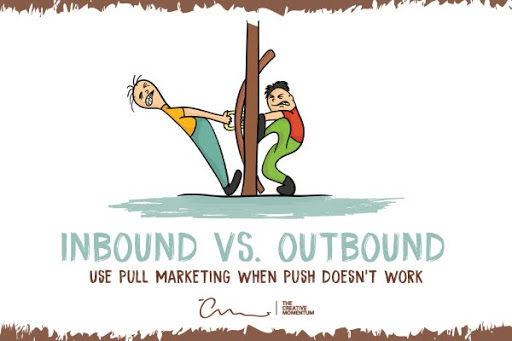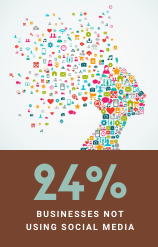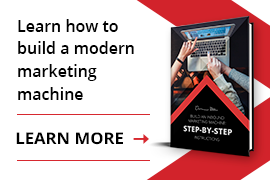 Have you ever tried to push a door open when the sign clearly says “pull?” It usrually doesn’t work out very well, and you end up going nowhere. The same is true for your company’s marketing: if you push when you should pull, you'll be unable to budge the door, and you’ll look dumb and embarrassed.
Have you ever tried to push a door open when the sign clearly says “pull?” It usrually doesn’t work out very well, and you end up going nowhere. The same is true for your company’s marketing: if you push when you should pull, you'll be unable to budge the door, and you’ll look dumb and embarrassed.
Before starting a new marketing campaign, it’s important to think about what your customers want. Do they want:
- an “in-your-face” outbound ad?
- or would they rather take their time and consume inbound content at their own pace?
Read the sign on the door; don’t push when you’re supposed to pull.
What’s the Difference Between Inbound and Outbound Marketing?
There are two approaches to modern marketing: inbound (pull) and outbound (push). Outbound marketing has been the standard until the late 20th century. It’s an interruption-based, broadcast strategy that consists of strategies like cold calls, billboards, and radio campaigns. The idea is to get your message in front of as many eyeballs as possible to see what sticks. In short: the bigger, the better.
Inbound (pull) marketing has gained momentum with the growing availability of information (the internet). Now, if consumers need a product to solve a problem, they head to the internet to find a solution. Inbound marketing is all about attracting customers to your brand by offering useful information and letting them dictate the selling process. It’s a more customer-centric approach that, as it turns out, is just as desirable for marketers as it is for buyers.
The Problem with Push Marketing
The short answer: It’s annoying. Nobody likes ad interruptions during TV shows and videos, and if a telemarketer calls, you can’t add yourself to the “do not call list” fast enough.
Prior to the internet, people had no choice but to put up with annoying outbound advertisements, but now, avoiding them is simple. DVRs let you skip TV ads, browser extensions remove ads from websites, and screening calls from unknown numbers is the default for most people. Most consumers can even tune out ads featured on the edges of their favorite websites. (Do you remember the ads on the side of your Facebook news feed?)
Back in 2007, the average person was exposed to over 5,000 ads per day. While there aren’t any official figures for 2020, it’s safe to assume that number has increased. How could anyone filter that much information, and more importantly, how can advertisers hope to stand out in such traffic? Here are some of the difficulties with modern outbound marketing:
- Difficult to track ROI
- Easy for consumers to block or avoid
- High cost with low yield
- Hard to target a specific audience
Focusing on a more inbound-heavy marketing approach allows brands to invite the customers to come to them and build a lasting relationship to sell products and services.
When the Sign Says “Pull”: Using Inbound Marketing

With outbound strategies becoming increasingly more expensive for less return, it’s time for brands to take a different approach to marketing. We know that people go online to find solutions to their problems; why not provide the answers and let them come to you?
1. Make Your Website Focus on the Customer
Inbound marketing for businesses is customer-centric, and your website should reflect this philosophy. Instead of focusing on YOUR brand, YOUR products, and YOUR services, think about what the customer really wants.
By creating helpful content that provides answers to common problems, you can draw customers to your website and gently lead them down the sales funnel. If you manage a company that makes water filters, don’t write a blog about technical details. Write about the health benefits of clean drinking water, how to tell if tap water is dirty, and then offer your product as a potential solution.
The initial goal is to attract prospects to your website, part of the "awareness" stage of inbound marketing. At this stage, the customer is aware they have a problem, and looking for solutions. By providing valuable content online that helps them with their problem, you build authority and trust with that prospect. Later, some of these prospects will come back later for more answers, and some will eventually convert into customers. Inbound marketing is all about authenticity with your customer relationship, and it is a long game, but well worth it.
2. Become a Thought Leader in Your Industry
As we mentioned, an important aspect of inbound marketing is building trust. You’re building a relationship, which takes more time. You need to prove that you’re an expert in your field so people trust your brand and your solutions.
Build a library of content that shows your expertise. Answer frequently asked questions, and provide solutions. If people view your company as a trust-worthy thought leader, they’ll come to you with all their problems, which leads to the natural outcome of greater sales and success for your business.
3. Engage with Potential Customers on Social Media
 Social media is a powerful marketing tool for both inbound and outbound tactics, but many businesses aren’t utilizing its full potential. Almost one-in-four businesses don’t use any social media, and just under half of the small businesses using social media don’t actively engage with their customers. Sure, a restaurant might post the monthly special, but it won’t respond to messages, reach out to customers, or keep up with trends.
Social media is a powerful marketing tool for both inbound and outbound tactics, but many businesses aren’t utilizing its full potential. Almost one-in-four businesses don’t use any social media, and just under half of the small businesses using social media don’t actively engage with their customers. Sure, a restaurant might post the monthly special, but it won’t respond to messages, reach out to customers, or keep up with trends.
Use social media—not just monthly updates—to build a relationship with potential customers. Talk to them, interact with them, and see what they’re looking for. The stronger your relationship with potential customers, the more likely they’ll use your brand to solve problems. It’s also a great way to check your brand’s reputation by monitoring reviews and general discussions.
4. Implement Marketing Campaigns Based on Inbound Data
Inbound tactics are also a great source of data. By tracking inbound metrics like page hits, time spent on-site, and conversion rates, you can see what content is most interesting to users, along with what’s not. Then, you can create more effective strategies based on those insights.
For instance, if you notice that a blog about carpet cleaning is getting much more attention than a blog about carpet replacement, you know that you should focus more effort on discussing effective cleaning solutions rather than promoting your latest carpet line.
Using automated tools to track important inbound metrics is a great way to analyze your data without spending too much time and effort.
Don’t Push When You’re Supposed to Pull
Inbound marketing is a more effective, and unobtrusive, way to attract people to your brand. By focusing on customers and letting them come to you, you build lasting relationships that result in more sales, higher ROI, greater brand trust, and overall, happier customers. Make your company a modern marketing machine by using effective inbound strategies.


